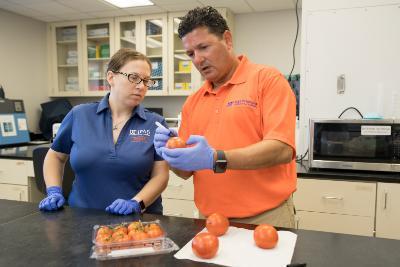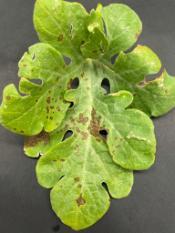Research Connections
RugoseMustGo: Protecting Tomatoes from the Emerging ToBRFV Threat
|
|
|
Dr. Ozgur Batuman Associate Professor of Pathology UF/IFAS SWFREC |
| Website (239)658-3408 obatuman@ufl.edu |
A new national project called RugoseMustGo—led in Florida by Dr. Ozgur Batuman at the University of Florida (UF/IFAS)—has been invited for full consideration by the USDA Specialty Crop Research Initiative (SCRI). The project brings together more than 20 researchers across the U.S. to fight a major new viral threat to tomato and other solanaceous crops: Tomato brown rugose fruit virus (ToBRFV).
Why It Matters
ToBRFV is a resistance-breaking tobamovirus that has caused serious crop losses in tomato-producing regions worldwide. The virus can spread quickly and survive on surfaces, making it difficult to control once established. While ToBRFV is still under quarantine in the U.S., its potential impact on our $2 billion tomato industry makes proactive action essential.
What the Project Will Do
If funded in early 2026, the RugoseMustGo team will work to:
- Develop AI-powered and robotic systems to detect and track the virus early.
- Create tomato varieties with strong, lasting resistance using modern breeding and biotechnology tools.
- Deliver practical management solutions and technologies that growers can use in real production systems.
Florida’s Role
In Florida, Dr. Batuman and his team will:
- Conduct surveys in commercial tomato and pepper transplant houses and field production sites across southwest, southeast, and central Florida.
- Collect and test plants showing virus-like symptoms to determine whether ToBRFV or related viruses are present.
- Work closely with the industry to improve detection and response capacity statewide.
How Growers Can Help
Grower and industry cooperation is key to success. Dr. Batuman welcomes collaboration with transplant producers, field growers, crop scouts, Extension agents, and consultants throughout Florida.
If you notice virus-like symptoms or have questions about potential ToBRFV infections, please reach out—your participation will help protect the state’s tomato industry.
Staying Connected
Project updates and results will be shared through UF/IFAS Extension events, grower meetings, field days, and online resources. Together, we can stay ahead of this emerging threat and ensure the continued success of Florida’s tomato industry.
Past Research Connections
| 8/4/2025 |
UF/IFAS Farm Labor Supervisor Certification Program |
 |
"UF/IFAS is excited to announce the launch of the online Farm Labor Supervisor Certification program on October 1, 2025. Designed to meet the needs of Florida’s agriculture and horticulture industries, this comprehensive training addresses key risks faced by farm operations and highlights the essential role of farm workers." |
| Kimberly Morgan Ag Economist |
|
| Website (540)750-1536 kimorgan@ufl.edu |
Keywords: farm workers, labor, farm labor, farm operations, certification |
-
Read: Developing Pest Management in Vegetable Crops
Vegetable crops are susceptible to several serious pests, including whiteflies, pepper weevils, armyworms, thrips, mites, and others. Effective pest management in vegetable crops, particularly within Integrated Pest Management (IPM) programs, relies on cultural, biological, and chemical control methods. Natural enemies such as predators, parasitoids, and entomopathogens present in the fields contribute significantly to the suppression of many of these pests. Most of these natural enemies, particularly predators and parasitoids, target the immature stages of the pests.
Pepper weevils present a unique challenge for biological control because their egg and larval stages are protected. Female pepper weevils create an egg cavity in flower buds or fruit using their mouthparts, deposit the egg in this cavity, and cover it with a light brown fluid that hardens and seals the opening. The egg, larval, and pupal stages develop within the fruit, shielded from natural enemies. While exploring the impact of biological control on pepper weevils, efforts are focused on determining the effects of insecticides and protective coverings on their populations.

Results from several studies on controlling pepper weevils using chemical control or screen barriers were presented at a recent grower meeting earlier this year. The highest level of weevil protection was observed in plots covered with screen barriers, which also resulted in improved yields. Newer insecticides provided equal or better suppression of pepper weevils compared to current grower standards. Integrating and rotating insecticide modes of action and tactics in pest management programs will help reduce pest populations and mitigate issues related to cost, resistance, and environmental contamination.
To view pepper weevil research results from Dr. Qureshi's presentation at the 2025 Pepper Grower Meeting - CLICK HERE (presentation begins at 1:54:00).
| 4/25/2025 |
Developing Pest Management in Vegetable Crops |
 |
"Vegetable crops are susceptible to several serious pests, including whiteflies, pepper weevils, armyworms, thrips, mites, and others. Effective pest management in vegetable crops, particularly within Integrated Pest Management (IPM) programs, relies on cultural, biological, and chemical control methods." |
| Jawwad Qureshi Entomologist |
|
| Website (239)658-3400 jawwadq@ufl.edu |
Keywords: Pest Management, Pests, Biological Control, Chemical Control, Vegetable Pests |
-
Read: Developing Pest Management in Vegetable Crops
Vegetable crops are susceptible to several serious pests, including whiteflies, pepper weevils, armyworms, thrips, mites, and others. Effective pest management in vegetable crops, particularly within Integrated Pest Management (IPM) programs, relies on cultural, biological, and chemical control methods. Natural enemies such as predators, parasitoids, and entomopathogens present in the fields contribute significantly to the suppression of many of these pests. Most of these natural enemies, particularly predators and parasitoids, target the immature stages of the pests.
Pepper weevils present a unique challenge for biological control because their egg and larval stages are protected. Female pepper weevils create an egg cavity in flower buds or fruit using their mouthparts, deposit the egg in this cavity, and cover it with a light brown fluid that hardens and seals the opening. The egg, larval, and pupal stages develop within the fruit, shielded from natural enemies. While exploring the impact of biological control on pepper weevils, efforts are focused on determining the effects of insecticides and protective coverings on their populations.

Results from several studies on controlling pepper weevils using chemical control or screen barriers were presented at a recent grower meeting earlier this year. The highest level of weevil protection was observed in plots covered with screen barriers, which also resulted in improved yields. Newer insecticides provided equal or better suppression of pepper weevils compared to current grower standards. Integrating and rotating insecticide modes of action and tactics in pest management programs will help reduce pest populations and mitigate issues related to cost, resistance, and environmental contamination.
To view pepper weevil research results from Dr. Qureshi's presentation at the 2025 Pepper Grower Meeting - CLICK HERE (presentation begins at 1:54:00).
| 3/12/2025 |
AI-Driven Soil and Ecosystem Services Monitoring for Everyone - Part 2 |
 |
"Recent advancements in Artificial Intelligence (AI) and remote sensing offer scalable solutions to address these challenges. Tools and technologies like the SoilAdvisor_Bot and Soil Data Cube , developed by the UF/IFAS Soil AI Lab, integrate satellite imagery, environmental covariates, and AI algorithms to provide accurate and actionable soil property maps. These tools enable researchers, farmers, and policymakers to make data-driven decisions that enhance productivity and sustainability." |
| Nikolaos Tziolas Soil Science AI |
|
| Website (239)658-3448 ntziolas@ufl.edu |
Keywords: Artifiial Intelligence, AI, Soils, precision agriculture |
-
Read: AI-Driven Soil and Ecosystem Services Monitoring for Everyone - Part 2
Recent advancements in Artificial Intelligence (AI) and remote sensing offer scalable solutions to address these challenges. Tools and technologies like the SoilAdvisor_Bot and Soil Data Cube , developed by the UF/IFAS Soil AI Lab, integrate satellite imagery, environmental covariates, and AI algorithms to provide accurate and actionable soil property maps. These tools enable researchers, farmers, and policymakers to make data-driven decisions that enhance productivity and sustainability.
SoilAdvisor_Bot on Telegram: Despite the abundance of satellites recording Earth data daily, this information remains largely inaccessible to end-users. To simplify access further, the UF/IFAS Soil AI Lab developed the SoilAdvisor_Bot. This chatbot delivers soil property maps directly to users’ mobile devices via Telegram. Users can specify their location using GPS or by typing a location name and select the desired soil property ( Figure 1). Within moments, the bot generates a map with a legend, making soil data portable and accessible during fieldwork or on-the-go decision-making.

Figure 1: Steps to Access Soil Property Maps Using SoilAdvisor_Bot on Telegram. A) Users can share their current location; B) manually enter a location name, and the bot confirms it; C) The bot processes the request and delivers a detailed CEC map with a corresponding legend; D) The bot processes the request and delivers a detailed SOC map with a corresponding legend. The QR code in the figure provides direct access to the SoilAdvisor_Bot, enabling users to add it to their Telegram application quickly.
The Technology behind the Products
The Soil Data Cube uses AI algorithms, including Random Forest, to model key soil attributes: clay content, soil organic carbon, cation exchange capacity, and pH. These attributes are essential for understanding soil health and improving land management. By processing satellite data in real time, the digital infrastructure automatically generates dynamic maps that can be updated annually, ensuring up-to-date information. A comparison of the Soil AI Lab’s 90-meter resolution maps with SoilGrids’ 250-meter resolution product highlights the advantages of finer-scale mapping (2). While both capture broader spatial trends, the Soil AI Lab’s maps provide greater detail.
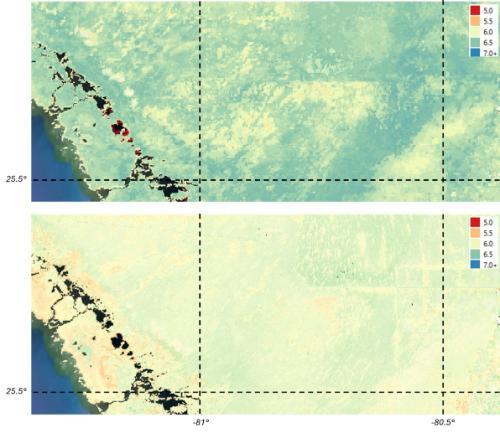
Figure 2: Comparison of pH maps of a region in the western Everglades area at two spatial resolutions. (A) Represents the SoilGrids product publicly available from ISRIC at a 250-meter resolution, while (B) shows the soil product generated by the Soil AI Lab’s Viewer at a finer 90-meter resolution.
Future Directions
The Soil Viewer and SoilAdvisor_Bot eliminate the need for complex software, making high-resolution soil data accessible to everyone. Future improvements will focus on integrating new datasets, improving the level of detail in maps, and expanding functionality to include additional soil attributes. These advancements will be driven by the ongoing projects at the Soil AI Lab, which aim to incorporate new soil data and develop more localized applications. While the current products rely on openly available data, the new efforts will generate more detailed and tailored information, providing local growers with actionable insights for their specific needs.
| 1/27/2025 |
AI-Driven Soil and Ecosystem Services Monitoring for Everyone - Part 1 |
 |
"Soils in Florida play a critical role in agricultural productivity and climate resilience. However, traditional soil analysis methods are costly and can be time-consuming, making them insufficient and inefficient for large-scale applications like precision agriculture. Recent advancements in Artificial Intelligence (AI) and remote sensing offer scalable solutions to address these challenges." |
| Nikolaos Tziolas Soil Science AI |
|
| Website (239)658-3448 ntziolas@ufl.edu |
Keywords: Artifiial Intelligence, AI, Soils, precision agriculture |
-
Read: AI-Driven Soil and Ecosystem Services Monitoring for Everyone - Part 1
Soils in Florida play a critical role in agricultural productivity and climate resilience. However, traditional soil analysis methods are costly and time-consuming, making them insufficient for large-scale applications like precision agriculture. For instance, Florida would require approximately 6,500 soil samples annually for effective management, making alternative solutions necessary.
Recent advancements in Artificial Intelligence (AI) and remote sensing offer scalable solutions to address these challenges. Tools like the Soil Viewer, developed by the Soil AI Lab, integrate satellite imagery, environmental covariates, and AI algorithms to provide accurate and actionable soil property maps. These tools enable researchers, farmers, and policymakers to make data-driven decisions that enhance productivity and sustainability.
Soil Viewer: The Soil Viewer is an online, user-friendly platform that allows users to interact with high-resolution soil property maps. Through its intuitive interface, users can define areas of interest, select soil properties (e.g., soil organic carbon, clay content, pH, cation exchange capacity), and generate detailed maps tailored to their needs as derived by AI regression algorithms able to transform spectral soil fingerprints to soil estimations of different properties (Figure 1). The maps are downloadable and come with legends explaining spatial variability, making the tool accessible to a broad audience, including farmers, researchers, and policymakers. The user can access the Soil Viewer via: https://viewer.soilslab.ai/
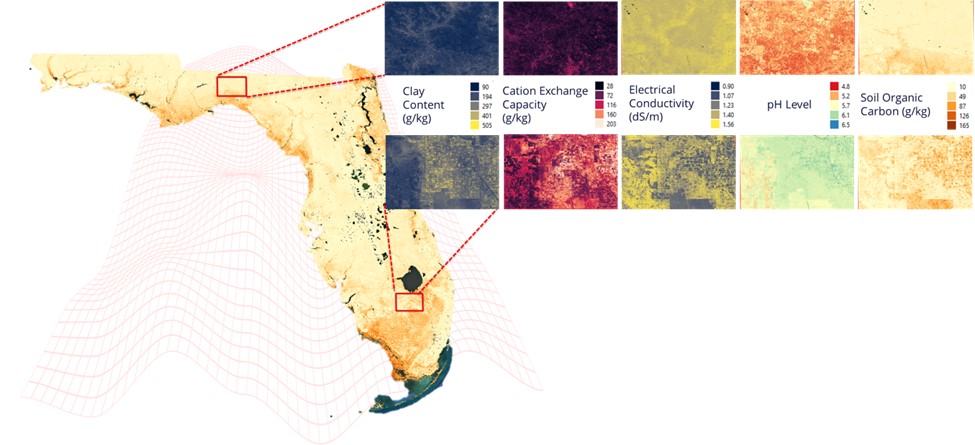
Figure 1: Maps available in the Soil Viewer showcasing soil attributes across the state of Florida
The Soil AI Lab’s tools are designed for simplicity and scalability. The Soil Viewer eliminates the need for complex software, making high-resolution soil data accessible to everyone. These tools provide a foundation for tracking soil health, supporting sustainable agricultural practices, and improving decision-making processes in real-time.
| 12/27/2024 |
New Methods for Detecting Tomato-infecting Viruses in the Field |
 |
"Florida tomatoes are constantly threatened by virus diseases such as tomato chlorotic spot virus (TCSV), tomato spotted wilt virus (TSWV), and tomato yellow leaf curl virus (TYLCV). To make field diagnosis more affordable and much easier for growers, we recently developed two novel methods to detect TCSV that can be performed by anyone for in-field detection of TCSV." |
| Ozgur Batuman Plant Pathologist |
|
| Website (239)658-3408 obatuman@ufl.edu |
Keywords: tomato, virus, TYLCV, tomato yellow leaf curl, tomato spotted wilt |
-
Read: New Methods for Detecting Tomato-infecting Viruses in the Field
Florida tomatoes are constantly threatened by virus diseases such as tomato chlorotic spot virus (TCSV), tomato spotted wilt virus (TSWV), and tomato yellow leaf curl virus (TYLCV). These and many other viruses are causing diseases in tomatoes with sometimes very similar symptoms, including leaf chlorosis, necrosis, and stunting of plants, and it is difficult to diagnose by looking at the symptoms alone. Therefore, we must always use molecular (e.g., PCR-based) or serological (e.g., lateral flow, a.k.a. rapid tests) tools to verify virus disease diagnosis.
To make field diagnosis more affordable and much easier for growers, we recently developed two novel methods to detect TCSV that can be performed by anyone for in-field detection of TCSV (see Figure below). The RT-LAMP assay relies on a hand warmer or similar device to heat the tubes and the color change of the reaction if plants are infected with TCSV. On the other hand, the RT-RPA assay does not need any heating device (i.e., you can hold the tubes in the palm of your hand to heat them) but relies on a lateral flow (i.e., rapid test strip) to read the test results. Both methods are highly sensitive and specific to detect TCSV and can be completed in the field in about 10-30 minutes. These two are the only field assays that can distinguish TCSV infection from those caused by TSWV, TYLCV, or ilarviruses, yet they are not commercially available. Batuman Lab can provide these assays free of charge to interested growers, nurseries, scouts, and extension agents to test them in their fields.
If growers need help with diagnosis, see unusual symptoms, or suspect they may have a new virus-like disease, they should immediately contact their local extension office for assistance or submit samples to their local UF-IFAS Plant Diagnostic Lab or FDACS-DPI (FDACS-DPI Helpline Number 352-395-4600). For help with virus testing, contact your County Extension Agent or Dr. Ozgur Batuman at UF/IFAS-SWFREC (obatuman@ufl.edu).

The figure depicts the main highlights of the two TCSV detection methods we developed. Both involve heat amplification methods. On the right, the RT-LAMP assay [reverse-transcription (RT) loop-mediated isothermal amplification: RT-LAMP], uses a handwarmer to heat the tubes to 60℃, and the color change from red to yellow indicates that the tomato is infected with TCSV. On the left, the RT-RPA assay [reverse-transcription (RT) recombinase polymerase amplification (RT-RPA)] can be done by holding the tubes in your hand for 10-20 min, and a lateral flow (i.e., a rapid test strip) dipped into the tubes to visualize two lines (i.e., control and test lines) confirming TCSV infection.
| 12/4/2024 |
Addressing Tomato Fruit Susceptibility and Fungicide Timing to Improve the Management of Target Spot, Caused by Corynespora cassiicola: Part 2 |
 |
"Target spot, caused by the fungus Corynespora cassiicola, is one of the costliest to the industry due to its impact on marketable yield at harvest and potential to cause additional losses during post-harvest packing operations." |
| Gary Vallad Plant Pathologist |
|
| Website (813)419-6577 gvallad@ufl.edu |
Keywords: soilborne, vegetable production, fumigation, fungicides, Fusarium, tomato |
-
Read: Addressing tomato fruit susceptibility and fungicide timing to improve the management of target spot, caused by Corynespora cassiicola: Part 2
Problem
Target spot, caused by the fungus Corynespora cassiicola, is one of the costliest to the industry due to its impact on marketable yield at harvest and potential to cause additional losses during post-harvest packing operations. No commercially available host resistance exists for target spot. Tomato production relies on fungicide applications for disease control, which raises concerns over the development of fungicide resistance.Trial 2. Evaluate the efficacy of fungicides on tomato fruit infection
Fruit harvested from tomato field trials (cv. Jolene) at the GCREC were sorted into large fruit at the breaker stage, surface sterilized and air dried. Fruit were then dipped in fungicide solutions prepared with Silwett L-77 (0.01% v/v ) or a Silwett L-77 and water solution for the non-treated control (Table 1). Individual fruits were inoculated with two C. cassiicola isolates and mock-inoculated with sterile water spaced equidistance around the sides of the fruit. Lesion diameter was measured 3 and 6 days after inoculation and percent control was based on the difference in lesion size of each fungicide-treated versus the Silwett L-77-treated control for individual isolates. The trial was repeated once.
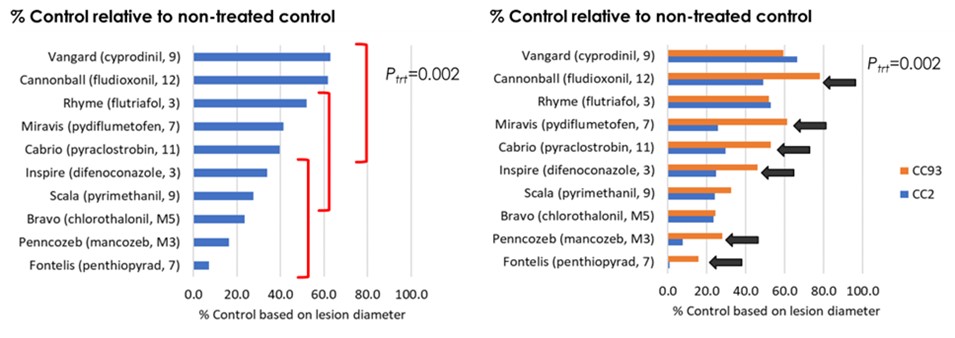
Both C. cassiicola isolates caused lesions on non-treated inoculated fruit but differed statistically in virulence based on lesion size (P < 0.0001) with lesions ranging from 0.8 to 1.1 cm for isolate 2 and from 1.0 to 1.4 for isolate 93.
On average, fruit treated with Vanguard, Cannonball, Rhyme, Miravis, and Cabrio provided the best control (Figure 4). Whereas, fruit treated with Fontelis, Penncozeb, Bravo, Scala, and Inspire were statistically equivalent to the control on average. When the performance against individual isolates was considered, several fungicide treatments differed in relative control, including Cannonball, Miravis, Cabrio, Inspire, Penncozeb, and Fontelis. C. cassiicola isolate 2 is a QoI (FRAC 11) resistant isolate, so the difference in control is expected. Whereas the difference in performance among fungicides in FRAC groups 3, 7, and 9 is new. In all cases, isolate 2 appeared to be more tolerant to fungicide treatments compared to isolate 93.
Many of the labeled fungicides the tomato industry relies on for managing target spot are formulated mixtures of FRAC groups 3, 7, 9, 11, and 12, but some of the best performing products across field trials contain cyprodinil and fludioxonil, such as Switch, Inspire Super, and Miravis Prime. Chairman, which is labeled for post-harvest fruit applications, also contains fludioxonil and performed well in prior fruit trials.
It’s important to highlight that the two C. cassiicola isolates used in these trials were originally collected in 2015 and do not reflect current populations. Hence, future studies should be conducted to evaluate current C. cassiicola populations against FRAC 3, 7, 9, and 12 fungicides, since these are the primary modes of action used by the tomato industry for managing target spot.
The observed differences in fungicide efficacy demonstrates the direct benefit of fungicide applications to protect fruit. In general, the observed differences among FRAC groups corresponded to prior field studies.
The results also indicate that further monitoring of C. cassiicola populations for fungicide resistance is necessary to improve overall fungicide management recommendations. This could be an even bigger concern if the label changes proposed by the EPA are imposed, which would limit chlorothalonil applications on tomato from the current rate of 15 lbs/acre/season to 6.5 lbs/acre/year. While the performance of chlorothalonil and mancozeb in reducing fruit infections was minimal, the contact nature of these materials may be compromised by the wound inoculation method used for the assessment.
If you have any other questions regarding Target Spot or other vegetable diseases, please feel free to reach out to Dr. Gary Vallad.
| 11/18/2024 |
Addressing Tomato Fruit Susceptibility and Fungicide Timing to Improve the Management of Target Spot, Caused by Corynespora cassiicola: Part 1 |
 |
"Target spot, caused by the fungus Corynespora cassiicola, is one of the costliest to the industry due to its impact on marketable yield at harvest and potential to cause additional losses during post-harvest packing operations." |
| Gary Vallad Plant Pathologist |
|
| Website (813)419-6577 gvallad@ufl.edu |
Keywords: soilborne, vegetable production, fumigation, fungicides, Fusarium, tomato |
-
Read: Addressing tomato fruit susceptibility and fungicide timing to improve the management of target spot, caused by Corynespora cassiicola: Part 1
Problem
Target spot, caused by the fungus Corynespora cassiicola, is one of the costliest to the industry due to its impact on marketable yield at harvest and potential to cause additional losses during post-harvest packing operations. No commercially available host resistance exists for target spot. Tomato production relies on fungicide applications for disease control, which raises concerns over the development of fungicide resistance.Prior studies evaluated 117 C. cassiicola tomato isolates collected from tomato production fields in Florida and identified >90% of the isolates were resistant to QoI fungicides (FRAC 11) and 75% were resistant to one or more SDHI fungicides (FRAC 7), while approximately three-quarters of the conventional fungicides labeled for target spot are QoI or SDHI fungicides.
Increased selection of resistance to the respiration inhibitors threatens the effectiveness of many fungicides available for target spot control. In addition, label changes proposed by the EPA for chlorothalonil would greatly limit the use of this contact fungicide for many crops produced in Florida (Docket EPA-HQ-OPP-2011-0840). The loss of contact fungicides like chlorothalonil and mancozeb would pose a challenge for many vegetable crops, since these economical products are commonly used early in the crop cycle as general maintenance sprays and as either a tank-mix or rotational partner for managing fungicide resistance against site-specific fungicides like the respiration inhibitors.

Trial 1. Determining tomato fruit susceptibility to infection by C. cassiicola during fruit development
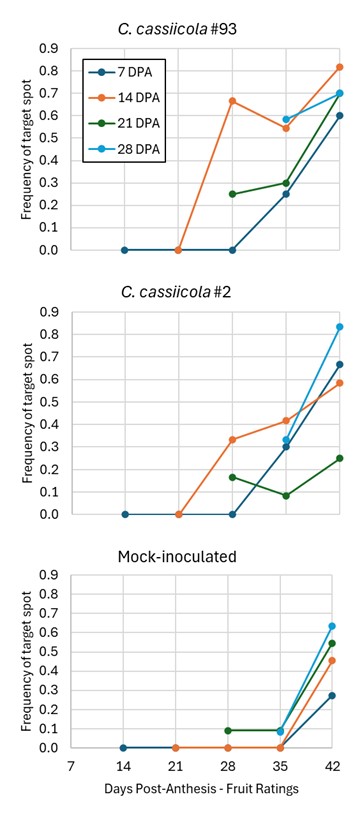 Field trials at GCREC were established to determine susceptibility of tomato fruit to C. cassiicola at different stages of fruit development. The results demonstrate that regardless of inoculation date, fruit became progressively more susceptible as they develop and ripen (Figure 3). On average, disease development on fruit inoculated 7 and 14 DPI required 14 days; while fruit inoculated at 21 and 28 DPI only required 7 days. We also observed target spot development on mock-inoculated fruit, but at a much lower frequency. Overall, these results are not too surprising, since packinghouses often observe that harvested green fruit exhibiting minor pinpoint lesions often progress into large lesions during the ripening process, leading to breakdown.
Field trials at GCREC were established to determine susceptibility of tomato fruit to C. cassiicola at different stages of fruit development. The results demonstrate that regardless of inoculation date, fruit became progressively more susceptible as they develop and ripen (Figure 3). On average, disease development on fruit inoculated 7 and 14 DPI required 14 days; while fruit inoculated at 21 and 28 DPI only required 7 days. We also observed target spot development on mock-inoculated fruit, but at a much lower frequency. Overall, these results are not too surprising, since packinghouses often observe that harvested green fruit exhibiting minor pinpoint lesions often progress into large lesions during the ripening process, leading to breakdown.In addition, the data shows the difference in virulence between the two C. cassiicola isolates, with higher percentage of fruit inoculated with isolate 93 developed lesions within 7 to 14 days compared to isolate 2 (at 14, 21, and 28 DPA). Also, on average fruit lesions produced by isolate 93 were 50% larger than those produced by isolate 2 (data not shown).
Regarding target spot developing on mock-inoculated fruit, developing fruit lesions sporulate profusely over time (see Figure 2). As such, the infection of the mock-inoculated fruit might be due to secondary infection from inoculated fruit, since many of the mock-inoculated fruit were often next to fruit inoculated with C. cassiicola out of convenience (easier to find as plant developed). Follow-up trials will inoculate fruit on greenhouse-grown compact-growth hybrid (CGH) plants to limit the potential of cross-infection.
Attempts were made to inoculate fruit without mechanical injury (puncturing) but were unsuccessful in the field. Hence, it is not possible to differentiate whether C. cassiicola can cause a latent infection (non-symptomatic infection) versus a quiescent infection (a visible infection that is not expanding). Subsequent greenhouse trials may help separate this difference, and test whether our observations are merely an artifact of our inoculation method. The decision to use field rather than greenhouse-grown plants was due to the large number of fruits required to conduct the experiment. Future greenhouse experiments can focus on a smaller number of inoculation timepoints, which will benefit work to evaluate differences in C. cassiicola aggressiveness on fruit and fruit susceptibility of breeding materials.
| 10/23/2024 | Exploring Methods to Enhance the Soil Environment for Increased Resiliency in Vegetable Production |
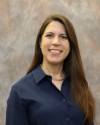 |
"Fumigation is a standard practice to control some soilborne plant pathogens and some weeds in vegetable production. However, the efficacy of fumigants can vary and it’s not clear how fumigants impact the other microbes in the soil (i.e. the microbes that are not pathogens). Many soil bacteria and fungi can be beneficial for plant growth, thus understanding if these beneficial microbes are still in the soil after fumigation, and how long it takes for them to return to the soil, could help optimize or improve fumigation practices." |
| Sarah Strauss Microbiologist |
|
| Website (239) 658-3468 strauss@ufl.edu |
Keywords: fumigation, soilborne, microbes, soil bacteria, soil fungi, vegetable |
-
Read: Exploring Methods to Enhance the Soil Environment for Increased Resiliency in Vegetable Production
Fumigation is a standard practice for vegetable production control of some soilborne plant pathogens and some weeds. However, the efficacy of fumigants can vary and it’s not clear how fumigants impact the other microbes in the soil (i.e. the microbes that are not pathogens). Many soil bacteria and fungi can be beneficial for plant growth, so understanding if these beneficial microbes are still in the soil after fumigation, and how long it takes for them to return to the soil, could help optimize or improve fumigation practices. Dr. Sarah Strauss, along with weed scientist Dr. Nathan Boyd, plant pathologist Dr. Gary Vallad, and soil scientist Dr. Mary Lusk, have been working on answering these questions through a USDA-NIFA grant. One of the early findings of their work is that fumigation with chloropicrin results in increases in bacteria and fungi, such as Bacillus and Trichoderma, that might be important in disease control and plant growth.
One of the potential limitations to altering the microbes that are present in Florida soils is the low amount of organic matter in our soils. Planting cover crops or applying compost are common methods for increasing organic matter, and thus resources for soil microbes. Given that we are seeing increases in potentially beneficial bacteria and fungi with fumigation, we were curious whether improving the resource availability for soil microbes through compost or cover crops before fumigation would result in greater increases in beneficial microbes after fumigation. Many of these potentially beneficial microbes can go dormant or form spores to survive conditions such as fumigation, and increasing the resources available to them through compost or cover could magnify the benefits to disease suppression. In addition, certain cover crops are known to deter nematodes, and thus planting them prior to vegetable production might help control those pests. Dr. Sarah Strauss was recently awarded a new grant from USDA-NIFA to address these questions for fumigants commonly used in Florida tomato and strawberry production. In addition, the project will also examine how changes in non-target soil microbes might impact the suppression of soilborne plant pathogens, nutrient availability, and weed growth. Vegetable horticulturalist Dr. Pavlos Tsouvaltzis, plant pathologist Dr. Gary Vallad, and nematologist Dr. Johan Desaeger are joining her on the project to help address these questions.
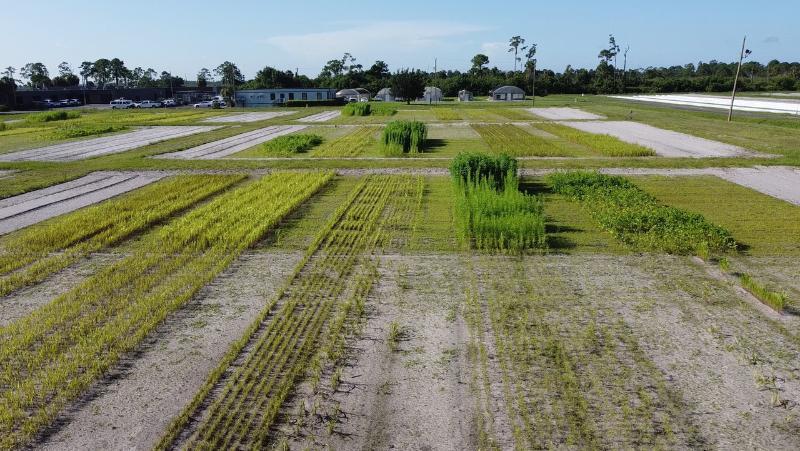
Cover Crop and Compost TrialInterested in learning more about fumigant impacts on soil microbes or participating in our trials? Contact Dr. Strauss and Craig Frey for more information.
| 9/16/2024 | Corn Silk Fly Ecology Research |
 |
"Euxesta stigmatias, Euxesta eluta, and Chaetopsis massyla are three picture-winged flies known as corn silk flies. These flies continue to be a major problem for sweet corn growers in southern Florida. Adults lay eggs on sweet corn silks and husks, and maggots feed on silks and kernels where they are protected from insecticides and natural enemies. Thus, current corn silk fly management targets adults with insecticides to prevent egg deposition." |
| Julien Beuzelin Entomologist |
|
| Website (561) 993-1599 jbeuzelin@ufl.edu |
Keywords: corn silk fly, sweet corn, Everglades, Euxesta stigmatias, Euxesta eluta, Chaetopsis massyla |
-
Read: Corn Silk Fly Ecology Research
Euxesta stigmatias, Euxesta eluta, and Chaetopsis massyla are three picture-winged flies known as corn silk flies. These flies continue to be a major problem for sweet corn growers in southern Florida. Adults lay eggs on sweet corn silks and husks, and maggots feed on silks and kernels where they are protected from insecticides and natural enemies. Thus, current corn silk fly management targets adults with insecticides to prevent egg deposition.
Corn silk flies typically become more challenging to control as the growing season progresses from the winter to the spring. However, the factors contributing to increased management difficulties have not been identified. On-farm research funded by a USDA NIFA Specialty Crop Research Initiative project led by Dr. Marcio Resende in the UF/IFAS Horticulture Department was initiated in 2024 to assist in determining corn silk fly population trends and identifying factors that influence pest severity.
Eighteen sites were selected on commercial farms and sampled from late winter to early summer 2024 to determine corn silk fly adult abundance and species composition throughout the peak of the production season in southern Florida. Two major crop consulting companies and four sweet corn growers assisted with research site selection.
Each site included a sweet corn field, or a group of sweet corn fields, planted between late December and early March. Sampling at each site was initiated in early February and was completed in early June. Thus, sampling was conducted before planting for many sites, and continued until after harvest for all sites. At each site, five corn silk fly traps were deployed 250 ft apart along a transect running 15-30 ft parallel to the sweet corn habitat. Corn silk flies captured in the traps were collected every 7-14 days, and the phenology of the sweet corn habitat and surrounding landscape within a 0.5-mile radius were characterized.
5,517 corn silk flies were captured (51.5% Euxesta stigmatias, 44.9% Euxesta eluta, 3.6% Chaetopsis massyla). Formal data analyses have not been conducted yet. Nevertheless, data show that trap captures for the three species combined increased as much as 70-fold from February to May (Fig. 1). In addition, the average proportion of E. stigmatias increased from 11% in February-March to 53% in April-June.
Fig. 1. Areawide corn silk fly trap captures in the Everglades Agricultural Area Silk Fly Adult (E. Stigmatias) This on-farm research is the first to document a general increase in corn silk fly numbers, as well as a relative increase in E. stigmatias numbers, during the sweet corn growing season. This increase in abundance of corn silk flies in general, and of E. stigmatias in particular, partially explains increasing corn silk fly management issues during the late spring because E. stigmatias has exhibited reduced susceptibility to insecticides.
Substantial increases in corn silk fly numbers often followed the termination of the sweet corn crop or the presence of field corn in the vicinity of the traps. Observations did not suggest that harvest of neighboring sugarcane fields contributed to an increase in corn silk fly numbers. However, high variability among sites was observed, suggesting that multiple interacting factors influence corn silk fly population dynamics.
Additional data collection during the next two growing seasons and further data analysis are expected to determine the contribution of factors influencing corn silk fly pest severity, which will assist with the implementation of production practices minimizing the build-up of damaging corn silk fly populations.
If you have any questions regarding pest management in vegetable production in the Everglades Agricultural Area, please feel free to reach out to Dr. Beuzelin for further information.
| 8/30/2024 | Improving S-Metolachlor Efficacy and Crop Safety in Plastic-Mulched Tomato Beds |
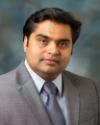 |
"The discontinuation of methyl bromide has led to a decline in broad-spectrum weed suppression, causing challenges for Florida's vegetable producers, especially with persistent weeds like purple and yellow nutsedge. These weeds can penetrate plastic mulch, have resilient tubers, and spread rapidly through rhizomes. To address this issue, a multi-strategy approach is necessary. Integrating pre-emergence herbicide application alongside fumigation could greatly enhance weed suppression in plasticulture beds." |
| Ramdas Kanissery Weed Scientist |
|
| Website (239) 658-3455 rkanissery@ufl.edu |
Keywords: methyl bromide, weed suppression, plasticulture, plastic mulch, vegetable, nutsedge |
-
Read: Improving S-Metolachlor Efficacy and Crop Safety in Plastic-Mulched Tomato Beds
The discontinuation of methyl bromide has led to a decline in broad-spectrum weed suppression, causing challenges for Florida's vegetable producers, especially with persistent weeds like purple and yellow nutsedge. These weeds can penetrate plastic mulch, have resilient tubers, and spread rapidly through rhizomes. To address this issue, a multi-strategy approach is necessary. Integrating pre-emergence herbicide application alongside fumigation could greatly enhance weed suppression in plasticulture beds. While pre-emergence herbicides effectively control nutsedge in vegetable production under plastic mulch, concerns about crop phytotoxicity and subsequent stress the crops may limit their application. One of the primary focuses of Dr. Kanissery's program is to enhance the utility and crop safety of pre-emergence herbicides in vegetable plasticulture production.
Although the co-application of pre-emergence herbicides with fertilizers has been explored in row crops, its potential in vegetable plasticulture systems remains largely unexplored. In a study funded by the FDACS specialty crop block grant, Dr. Kanissery's team evaluated the efficacy and safety of the pre-emergence herbicide S-metolachlor (active ingredient or a.i in products like Dual Magnum II) in tomato plasticulture. Field trials at the University of Florida's Southwest Florida Research and Education Center in Immokalee involved applying S-metolachlor at the recommended rate (1 kg a.i ha-1) on raised beds before laying plastic mulch. The herbicide was either applied alone as sprays or side-dressed onto beds coated with slow-release chelated iron fertilizer. Previous studies have examined the use of iron supplements alongside herbicides to reduce herbicide toxicity in crops. Furthermore, prior reports have shown that fertilizers, such as chelated iron, hold potential as slow-release agents for pre-emergence herbicides like S-metolachlor.
Results showed that using S-metolachlor alone effectively reduced purple nutsedge density compared to the untreated control in all the trials. Combining S-metolachlor with chelated iron also resulted in a reduction of purple nutsedge density compared to the untreated control. These treatments did not negatively affect chlorophyll content or crop yield compared to the control.
Notably, tomato yield significantly decreased with increased purple nutsedge density in the beds. Overall, the study suggests that using S-metolachlor alone or in combination with slow-release fertilizer effectively reduces purple nutsedge infestation in plastic-mulched raised beds without compromising tomato health and productivity.
Dr. Kanissery and his team are also investigating the synergistic effects of different pre-emergent herbicide products when applied as tank mixtures under plastic mulch. This approach could potentially reduce herbicide rates and manage weed tolerance more effectively, particularly for tough weeds like nutsedge.
Dr. Kanissery has new research and recent results on Improving S-Metolachlor Tolerance in Tomato Transplants Through a Novel Seed Treatment-Based Herbicide Safening - To enhance weed control in plasticulture beds, especially against persistent weeds like nutsedge, a multi-strategy approach combining pre-emergence herbicides with fumigation is essential. However, concerns over potential crop injuries from pre-emergence herbicides limit their use under plastic mulch. This research explores how safeners such as benoxacor and fenclorim protect tomato transplants from damage caused by S-metolachlor (the active ingredient in Dual Magnum), a commonly used pre-emergence herbicide for controlling nutsedge in plastic-mulched tomato beds. The findings suggest that these safeners, when applied as seed treatments, may enhance the protection of tomato transplants by potentially increasing the activity of glutathione S-transferase (GST), thereby reducing stress caused by S-metolachlor.
The figure below illustrates the positive effects of Benoxacor and Fenclorim safeners, used as seed treatments, on the plant vigor and root mass of tomato plants grown in soils treated with pre-emergence herbicide S-metolachlor compared to NO-safener treated controls
If you have any questions regarding weeds in vegetable production or the use of herbicides for their management, please feel free to reach out to Dr. Kanissery for further information.

| 8/2/2024 | Grant for Sustainable Anthracnose Management (SAM) in Cucurbits |
 |
"Drs. Pamela Roberts, Geoffrey Meru, and Gary Vallad are UF collaborators on a recently funded, multi-state grant led by Dr. Bhabesh Dutta, University of Georgia, addressing Sustainable Anthracnose Management (SAM) on cucurbits. The grant focuses on anthracnose as an emerging threat to watermelon and cucumber." |
| Pamela Roberts Plant Pathologist |
|
| Website (239) 658-3430 pdr@ufl.edu |
Keywords: watermelon, anthracnose, cucumber, cucurbits, fungus, Colletotrichum |
-
Read: Grant for Sustainable Anthracnose Management (SAM) in Cucurbits
Drs. Gary Vallad, Geoffrey Meru, and Pamela Roberts are UF collaborators on a recently funded, multi-state grant led by Dr. Bhabesh Dutta, University of Georgia, addressing Sustainable Anthracnose Management (SAM) on cucurbits. The grant focuses on anthracnose as an emerging threat to watermelon and cucumber. The overarching goal of the grant is to reduce economic losses from anthracnose through tools and information developed by the grant to increase grower profitability.
Cucurbit anthracnose is caused by the fungus Colletotrichum orbiculare and other Colletotrichum species. Anthracnose on watermelon and cucumber has been of growing importance in Florida with more outbreaks detected in south and central production fields. Losses from anthracnose are caused by plant defoliation from lesions on leaves, peduncles, and stems. Fruits with lesions are non-marketable.
The Florida team will work on grant objectives addressing the pathogen, management, and host resistance. Roberts will conduct field surveys, fungicide sensitivity, pathogenicity, and race typing. This work will be used by grant team members doing population genomics and diagnostic assay development. Meru will screen commercial cucurbit varieties and plant introduction lines for resistance. Vallad will conduct field trials testing fungicide efficacy and environmental production practices. Additional grant team outputs will include multistate extension efforts and economic assessments on grant outcomes.

Anthracnose on watermelon fruit
photo credit: Dr. Pam RobertsAnthracnose on watermelon leaf
photo credit: Dr. Katherine Hendricks
| 7/23/2024 | Update on Common Purslane Management in Leafy Vegetables |
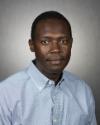 |
"Dr. Calvin Odero's research focuses on development of effective integrated weed management programs for sugarcane and vegetables on both organic and mineral soils of south Florida. Research in bioenergy crops actively pursues management of potential escapes in sugarcane and vegetables." |
| Calvin Odero Weed Specialist |
|
| Website (561) 993-1509 dcodero@ufl.edu |
Keywords: weed, leafy vegetables, lettuce, purslane |
-
Read: Common purslane management in leafy vegetables
Common purslane is the most problematic and difficult to control broadleaf weed in leafy vegetables, including lettuce. Prevalence of common purslane in the Everglades Agricultural Area (EAA) where leafy vegetable production occurs is attributed to its prolific seed production, ability to grow under warm moist soils presently prevalent throughout most of the season, and tolerance of management practices. Common purslane has shown tolerance to imazethapyr, the only herbicide for broadleaf weed control in leafy vegetables in the region. Mechanical cultivation used to supplement chemical control does aggravate common purslane’s persistence because of the ability of its fragments chopped during cultivation to regenerate and reinfest the crop. This has resulted in growers relying on costly hand weeding to supplement chemical control. Thus, it is important to develop management programs for growers that are less dependent on hand labor. Consequently, alternative efficacious herbicides with activity on common purslane and other broadleaf weeds are needed to minimize negative effect of weeds on leafy vegetables production.
Our preliminary data indicate that pendimethalin can potentially be safely used to mitigate negative effects of common purslane on leafy vegetables. Pendimethalin is a dinitroaniline herbicide primarily used for control of grass and certain broadleaf weeds. We are presently evaluating (i) common purslane control programs using pendimethalin (at 1 and 2 lb ai/acre) in combination with other weed management strategies, (ii) the effect of temperature and moisture on common purslane recruitment processes, and (iii) the persistence of pendimethalin in leafy vegetable production soils in the EAA. To maintain high yields, quality, and economic viability in leafy vegetable production, development of an integrated common purslane management is important for growers in the EAA.

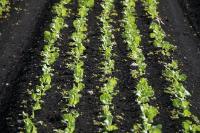
Common purslane in a lettuce field.
| 6/21/2024 |
One of the Main Pests that Florida Farmers Face: Plant-Parasitic Nematodes |
 |
"Dr. Johan Desaeger’s Gulf Coast Nematology laboratory studies plant-parasitic nematodes which are one of the main pests that Florida farmers face. The lab works primarily on developing integrated nematode management strategies for reducing nematode impacts. This includes evaluating nematicides, cover crops and resistant cultivars, as well as studying the impact of these practices on soil health and quality and natural nematode suppression." |
|
Johan Desaeger Entomology and Nematology |
|
| Website (813)419-6592 jad@ufl.edu |
Keywords: nematode, soil health, nematicide, cover crops, tomato, pest |
-
Read: One of the Main Pests that Florida Farmers Face: Plant-Parasitic Nematodes
Dr. Johan Desaeger’s Gulf Coast Nematology laboratory studies plant-parasitic nematodes which are one of the main pests that Florida farmers face. The lab works primarily on developing integrated nematode management strategies for reducing nematode impacts. This includes evaluating nematicides, cover crops and resistant cultivars, as well as studying the impact of these practices on soil health and quality and natural nematode suppression.
Ongoing research projects include an FDACS-funded project in collaboration with Dr. Mary Lusk evaluating vegetable farm cover crop practices to improve nematode management, nitrogen utilization and water quality. Cover crop treatments include pure stands and mixtures of sunn hemp, sorghum sudangrass and southern pea. Previous research has shown that sunn hemp and sorghum sudangrass are poor hosts to many species of root-knot nematodes and good cover crop options for Florida vegetable farmers (Table 1). The new project seeks to quantify how these cover crops and their mixtures not only affect root-knot nematodes but also other nematode populations, leaching and availability of nitrogen, and yield of tomato and zucchini.
Table 1. Nematode reproduction on four cover crops (and tomato) eight weeks after inoculation with the four most common root knot nematode (RKN) species in Florida vegetable fields (Meloidogyne arenaria, M. enterolobii, M. incognita, M. javanica).

Another project funded by the Florida Tomato Committee is investigating the prevalence of guava root-knot (Meloidogyne enterolobii) and stubby root (Nanidorus minor) nematodes in Florida tomatoes. Both nematodes are common in Florida fields but remain relatively unknown. The damage from guava root-knot nematode can be severe but indistinguishable from other root-knot species. What makes guava root-knot more dangerous is that this species will break currently available root-knot nematode resistance in tomatoes. The damage that stubby root nematodes cause is less clear, but this nematode may (or may not) be associated with yellow top symptoms in mature tomato plants. We are still investigating this, as well as the possibility that stubby root nematodes could transmit a virus (as is the case in potatoes where they cause tuber corky ringspot). This work is done in collaboration with USDA (Dr. Scott Adkins).
If you have any concerns about nematodes in your fields, don’t hesitate to reach out to your local county Extension agents or to jad@ufl.edu. We’re there to help.
Sunn hemp cover crop (Crotalaria juncea)
Guava root knot nematode galls on tomato Yellow top on tomato (possibly associated with stubby root nematodes) 




| 6/4/2024 |
The Value of Integrating Data from Nondestructive Assessment of Plant Physiology in Real Time Monitoring of Vegetable Crops' Performance |
 |
"Growers are already aware of the importance of optimizing soil and water management practices, and are adopting strategies to mitigate adverse weather impacts, ultimately aiming to enhance sustainable vegetable farming practices. Therefore, regular soil analysis for mineral content and monitoring soil moisture, water quality, air temperature, relative humidity and solar radiation are common practices." |
|
Pavlos Tsouvaltzis Vegetable Horticulture |
|
| Website (239)658-3444 ptsouv@ufl.edu |
Keywords: vegetable, tomato, nutrient management, crop production management, chlorophyll, soil |
-
Read: The Value of Integrating Data from Nondestructive Assessment of Plant Physiology in Real Time Monitoring of Vegetable Crops' Performance
Growers are already aware of the importance of optimizing soil and water management practices, and are adopting strategies to mitigate adverse weather impacts, ultimately aiming to enhance sustainable vegetable farming practices. Therefore, regular soil analysis for mineral content and monitoring soil moisture, water quality, air temperature, relative humidity and solar radiation are common practices.
However, beyond the above, information from actual plant responses should be integrated in data-driven crop production management strategies. In other words, growers need a new approach to confirm in real-time that plants are efficiently assimilating water and nutrients and rapidly prevent any imminent disorders.
There are several tools nowadays to achieve that by using portable equipment that reveal the plants’ physiological state capturing nondestructive measurements on leaves:
- Stomatal conductance: refers to the rate at which CO₂ enters and water vapor exits the leaf through stomata. It influences photosynthetic and transpiration rates and may relate to the optimization of water use efficiency and nutrient uptake.
- Chlorophyll content: Indicative to photosynthetic rate, it is also closely linked to the nutritional status of the plant, especially nitrogen which is a main element of chlorophyll structure, and its deficiency can be detected as chlorosis (yellowing of leaves).
- Chlorophyll fluorescence: the emission of light by chlorophyll molecules during the return from an excited to a ground state. It may be an indicator of plant stress, such as drought, heat, or nutrient deficiency, which impacts photosynthesis by damaging the photosynthetic apparatus or reducing its efficiency.
- Spectral reflectance: energy that is reflected by the plant at different wavelengths either in the visible (400-700 nm), or near infrared (700-2,500 nm) region of the electromagnetic spectrum. Specific wavelengths or combinations of wavelengths (e.g., NDVI - Normalized Difference Vegetation Index) are used to assess plant health and vigor, or even detect individual components, such as water content, or specific minerals and organic compounds.
By combining these measurements with soil and weather data, a more precise monitoring of plant health and early detection of nutrient deficiencies can be accomplished. This approach holds great potential for the growers, although currently these techniques cannot be very easily adapted, due to the high cost of purchasing the equipment and the advanced knowledge which is needed for processing the generated data. More research is needed to improve the current scientific knowledge and when consistent results confirm the reliability of the approach, the market will balance the needs of the agricultural community.
This is the objective of a funded project ‘AI-enabled plant phenotyping for novel nutrient management in tomatoes’ under the collaboration of Dr. Pavlos Tsouvaltzis and Dr. Yiannis Ampatzidis, in order to develop an Artificial-Intelligence tool that will help growers to adjust nutrient supply based on nondestructive, remote sensing, on-ground and above ground techniques, monitoring the physiological status of plants.
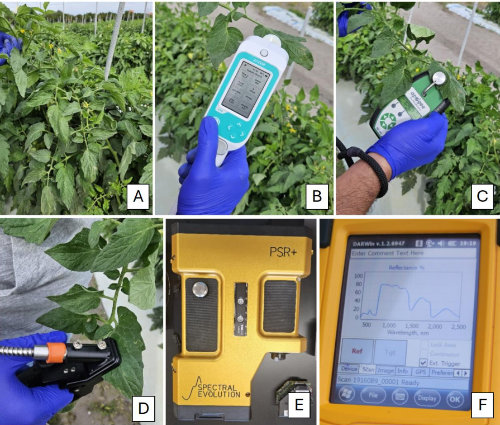
Figure 1. Tomato plant (A) and measurements of stomatal conductance and chlorophyll fluorescence (B), chlorophyll content (C), and capturing of spectral reflectance on a leaf (D). Visible to near infrared spectroradiometer (E) and a typical spectral curve of a healthy plant at 350-2,500 nm (F).
| 2/7/2024 |
Research Update on the Management of Vegetable Insect Pests in Miami-Dade County |
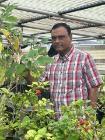 |
"Dr. DAK Seal's research and extension responsibilities focus on investigating key aspects of the most damaging insect pests of vegetable crops in South Florida." |
|
Dakshina (DAK) Seal Entomologist |
|
| Website (786)217-9269 dseal3@ufl.edu |
Keywords: thrips, insects, vegetable insects, South Florida, Tropical Research |
-
Read: Research Update on the Management of Vegetable Insect Pests in Miami-Dade County
Dak Seal's Entomology Team at the Tropical Research & Education Center in Homestead, FL is addressing the development of a management program for controlling melon thrips (Thrips palmi), Asian bean thrips (Megalurothrips usitatus), pepper thrips (Thrips parvispinus), pepper weevil (Anthonomus eugenii), and diamondback moth (Plutella xylostella).
A preliminary study was completed to start developing a management program for controlling Thrips parvispinus in finger hot pepper. Other trials are on-going and results will be shared at a later date. Two studies were conducted in commercial pepper fields in Miami-Dade County, FL, to evaluate the efficacy of various insecticides for controlling T. parvispinus. The fields were planted to finger hot chili pepper in May 2023. Pepper plants were set on raised beds covered with white-on-black plastic mulch. Plant spacing within the beds was 2 feet and in between beds was 6 feet. The fields were managed by using standard practices as mentioned in the Vegetable Production Handbook of Florida. Various insecticide treatments and their rates/acre used in these studies are shown in the tables. Treatment plots consisted of 10-feet-long 2 beds and were arranged in a randomized complete block design replicated 6 times. In both fields, treatments were applied 3 times on 28 Jun, 8 Jul, and 15 Jul 2023 at weekly intervals delivering 50 gpa using a backpack sprayer at 30 psi. Evaluation was made by randomly collecting 10 full-grown young leaves from the top canopy of pepper plants 24 h after each application. Leaf samples were transported to the laboratory and washed with 70% ethanol to separate thrips and identified species using a binocular microscope at 10× magnification. Data were statistically analyzed using SAS Proc. GLM after square root transformation, and means were separated by Duncan multiple range test. Untransformed means were presented in the tables.
Thrips parvispinus abundance was medium during the first study. On the first sampling date, all insecticide treatments in the first study, except Minecto Pro, significantly reduced T. parvispinus adults when compared with the untreated control (Table 1). On the second sampling date, the mean number of T. parvispinus adults was significantly fewer in all treated plants than in the untreated control. However, Sivanto-treated plants did not differ from the untreated control in the mean number of adults. On the third sampling date, all insecticide treatments significantly reduced T. parvispinus adults on pepper plants. The mean number of T. parvispinus adults/sample across all sampling dates mirrored the third sampling date. In a second study, Plinazolin, a new Syngenta insecticide that is currently undergoing EPA review, significantly reduced T. parvispinus as averaged from 3 sampling dates (Fig. 1).
Table 1.
Mean number of T. parvispinus adults/leaf sample
Treatments
Rate [oz]/acre
First sample
Second sample
Third sample
Mean
Radiant SC
8.0
4.25bc
0.67b
0.67b
2.10b
Minecto Pro SC
10.0
5.25ab
0.00b
1.33b
2.50b
Sivanto SL
21.0
3.25bc
1.67ab
1.33b
2.20b
Lannate LV
36.0
3.00bc
1.67ab
1.67b
2.20b
Torac EC
21.0
2.25c
0.67b
0.00b
1.10b
Novaluron EC
12.0
1.75c
0.00b
0.00b
0.70b
Untreated Control
8.75a
3.00a
4.33a
5.70a
P value
0.002
0.038
0.019
0.0002.
Means within a column followed by the same letter(s) do not differ significantly (P > 0.05, DMRT).
Means between bars with the same lowercase letter do not differ statistically (P > 0.05; DMRT).
Figure 1.

Means between bars with the same lowercase letter do not differ statistically (P > 0.05).
This study provides preliminary information about combating an initial infestation of T. parvispinus in commercial pepper fields.1
| 12/18/2023 |
Research Update on the Emerging Disease: Tar Spot of Corn in Southern Florida |
-100x125.jpg) |
"Dr. Katia Xavier's research program focuses on the development of integrated strategies to help growers effectively manage diseases on vegetables, sugarcane, rice, and commercial sod produced in the Everglades Agricultural Area (EAA)." |
| Katia Viana Xavier Plant Pathologist |
|
| Website (561)993-1500 kvianaxavier@ufl.edu |
Keywords: Tar Spot, corn disease, Phyllachora maydis, sweet corn, fungus |
-
Read: Research Update on the Emerging Disease: Tar Spot of Corn in Southern Florida
Effective disease management remains a paramount concern for growers in every growing season. The introduction of tar spot disease to the United States in 2015, swiftly followed by its appearance in Florida's fields in 2016, has directed focused research efforts led by Dr. Katia Xavier and her team. In 2022, the Foundation for Food & Agriculture Research (FFAR) recognized the urgency of the situation and awarded a Rapid Outcomes from Agricultural Research (ROAR) grant. One of the overarching goals was to unravel the epidemiological factors and genetic diversity of tar spot in the state.
The research initiative commenced with a thorough survey of maize fields across Florida to gauge the incidence (number of infected plants in a given field) and severity (percentage of infected leaf area) of tar spot. The results revealed a promising trend, with the incidence and severity of tar spot notably lower than in previous years. Out of the 36 fields surveyed, 23 exhibited no tar spot, and 4 fields had severity below one percent. Even in the fields where incidence was above 50%, the severity ranged only between 5 to 12%.
Symptomatic leaves were collected from all fields with tar spot to study the pathogen’s population. Preliminary findings from this study provided a crucial insight: all instances of tar spot on maize were caused by the fungal species Phyllachora maydis. This valuable knowledge is guiding the refinement of strategies for effective tar spot management.
Beyond identifying the causative pathogen, understanding the dissemination and survival dynamics of P. maydis is pivotal. Dr. Xavier and her team conducted a survival study burying tar spot-symptomatic corn leaves in muck soil from the Everglades Agricultural Area, and rocky soil from Miami-Dade County, periodically assessing germination of tar spot spores. This revealed low levels of germination during the months of May through September. Whereas further assessments during cooler months are warranted, this initial insight suggests the current cultural practices performed by South Florida sweet corn growers such as tillage is a viable management option for controlling this disease.
Picture of corn leaf infected with tar spot:

This ongoing work on tar spot highlights its significance. If you have encountered this disease, we encourage you to reach out to Dr. Xavier (kvianaxavier@ufl.edu) or your local county Extension agent, contributing to the collective effort to mitigate the potential impact of tar spot on south Florida sweet corn.
| 10/26/2023 |
Integrated Management of Soilborne Pathogens Impacting Vegetable Production in Florida |
 |
"Dr. Gary Vallad is carrying out research to improve the management of soilborne pathogens, such as Fusarium wilt and Southern blight of tomato, through the integrated use of biological, chemical, and cultural control strategies and host resistance." |
| Gary Vallad Plant Pathologist |
|
| Website (813)419-6577 gvallad@ufl.edu |
Keywords: soilborne, vegetable production, fumigation, fungicides, Fusarium, tomato |
-
Read: Integrated Management of Soilborne Pathogens Impacting Vegetable Production in Florida
Soilborne pathogens can cause significant yield losses to vegetable production. Their ability to survive in soil for long periods of time and broad host range can make management challenging. Growers have long relied on soil fumigation to manage soilborne pathogen populations. However, soil fumigation only provides a temporary reduction in pathogen levels, which for diseases like Fusarium wilt of tomato only delays symptom development. Supplemental fumigant applications to the edges of beds or deeper within the soil profile can improve management. However, increasing fumigation costs have many growers looking for ways to trim their fumigant rates. Dr. Vallad’s program is investigating several strategies to improve the management of soilborne pathogens through the use of fungicides (Table 1) and biopesticides.
Table 1. Evaluation of drench and drip applications of adepidyn, fludioxanil, and Miravis Prime for the management of Fusarium wilt on tomato.
Treatment, rate/A (applic.) z
XL yield
(lbs/plot)y
Disease
Incidence (%)
Non-treated control
34.4
bc
82.6
a
Adepidyn, 13.7 fl oz (drench 0, drip 2)
45.0
ab
40.7
bc
Adepidyn, 11.5 fl oz (drench 0)
46.9
a
56.8
abc
Fludioxanil, 8 fl oz (drench 0)
30.4
c
63.0
ab
Miravis Prime, 15.4 fl oz
(drench 0, drip 2)
43.3
ab
47.1
abc
Miravis Prime, 15.4 fl oz (drench 0)
45.4
ab
53.9
abc
EXP 1, 11.4 fl oz (drench 0)
45.9
ab
45.7
abc
Fludioxanil, 8 fl oz (drench 0);
EXP 1, 11.4 fl oz (drench 0)
42.1
abc
16.9
c
Non-inoculated control
34.4
bc
32.1
bc
z Rates are based on a row acre, with drip and drench applications (applic.) Made at plant (0) or two weeks (2) after planting.
y Extra-large (xl) fruit yield (20 ft plot) was hand-harvested twice at the end of the trial.
Dr. Vallad is also working with a team of researchers at USDA-ARS, University of California-Davis, and Pennsylvania State University to develop molecular-based methods for improved diagnostics of Fusarium pathogens on tomato and to monitor their populations in agricultural soils. The ability to differentiate pathogenic from non-pathogenic forms of Fusarium oxysporum will allow Dr. Vallad’s program to address the impact of cultural practices, such as cover crop rotations, fallow periods, and soil inputs on pathogenic Fusarium populations.

FIGURE 1. Tomato plants exhibiting classic symptoms of Fusarium wilt. Initial chlorosis and wilting of foliar tissues is typically asymmetrical, beginning with lower leaves and progressing upwards over time. Vascular discoloration can be observed in lower and upper symptomatic stems of plants. As wilt progresses, foliage becomes necrotic leading to plant death.
Genetic crop resistance is another option but limited to certain crops and to select soilborne pathogens, such as the available resistance to all three known races of Fusarium wilt in tomato. The deployment of disease resistant crop varieties is the most effective means to manage any disease. However, a recent breakdown in commercially available resistance to Fusarium wilt race 3 has raised concerns, since many tomato growers have adopted resistant varieties throughout the state. Dr. Vallad’s program would like growers and consultants to pay special attention to those tomato fields with Fusarium wilt race 3 resistant cultivars for any symptoms of Fusarium wilt (Figure 1). Growers and consultants are encouraged to alert Dr. Vallad (gvallad@ufl.edu or 813-419-6577) if they observe evidence of Fusarium wilt on Fusarium wilt race 3 resistant tomato cultivars or are interested in participating in future studies focused on the management of soilborne pathogens.
| 10/9/2023 |
A New Invasive Thrips Impacting South Florida Pepper Production: Thrips parvispinus |
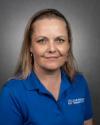 |
"Thrips parvispinus is an invasive polyphagous thrips impacting vegetable and ornamental productions. It was first detected in the continental U.S. in a greenhouse in Orange County, Florida in August 2020. The insect was observed in the landscape in Miami-Dade County in early 2022, and on a gardenia hedge on Palm Beach Island in the spring of 2022. Samples collected in November 2022 in a pepper field in eastern Palm Beach County were confirmed as T. parvispinus by FDACS-DPI. This was the first record of an established population in a vegetable field" |
| Anna Mészáros County Vegetable Agent |
|
| Website (561)233-1718 ameszaros@ufl.edu |
Keywords: thrips, new pest, scouting, vegetable, pepper, insect, monitoring |
-
Read: A New Invasive Thrips Impacting South Florida Pepper Production: Thrips parvispinus
First detections
Thrips parvispinus is an invasive polyphagous thrips impacting vegetable and ornamental productions. It was first detected in the continental U.S. in a greenhouse in Orange County, Florida in August 2020. The insect was observed in the landscape in Miami-Dade County in early 2022, and on a gardenia hedge on Palm Beach Island in the spring of 2022 (Fig. 1). Samples collected in November 2022 in a pepper field in eastern Palm Beach County were confirmed as T. parvispinus by FDACS-DPI. This was the first record of an established population in a vegetable field (Fig. 2, 3). Fig. 1. T. parvispinus injury on gardenia on Palm Beach Island.
Fig. 1. T. parvispinus injury on gardenia on Palm Beach Island.
Fig. 2. First observation of T. parvispinus infesting a pepper field in Palm Beach County.
Fig. 3. Deformed pepper plant due to T. parvispinus feeding.Identification
T. parvispinus females and males differ in size and color. The females are larger and have a yellowish-brown thorax and a black or dark brown abdomen (Fig. 4). The males are yellowish and smaller than the females. All leg segments are light colored. The third and the base of the 4th and the 5th antennal segment are light colored. An in-depth identification guide can be found here: https://commercialveg.ifas.ufl.edu/identification-resources/.
Fig. 4. T. parvispinus female.Field observations in Palm Beach County
In December 2022, commercial pepper fields were visited in East Palm Beach County with a crop consultant to observe injury and assess infestations. All life stages of T. parvispinus were found on all parts of the pepper plants, including flowers and fruits (Fig. 5, 6). Heavily distorted leaves and flower buds resembling broad mite injury were observed (Fig. 7). T. parvispinus injury caused substantial economic losses in these pepper fields. Fig. 5. T. parvispinus females on a pepper flower.
Fig. 5. T. parvispinus females on a pepper flower.
Fig. 6. T. parvispinus injury on a pepper.
Fig. 7. Deformed pepper plant due to T. parvispinus feeding.In the spring of 2023, T. parvispinus specimens were collected for the first time on cucumber, yellow squash, and zucchini (Fig. 8, 9). High numbers of adults and heavy feeding injury were observed on cucumber leaves. However, fruits only showed minor cosmetic damage (Fig. 10). T. parvispinus was also identified in a snap bean field by collecting flowers and leaves. Potential damage due to T. parvispinus on snap bean is still unknown.
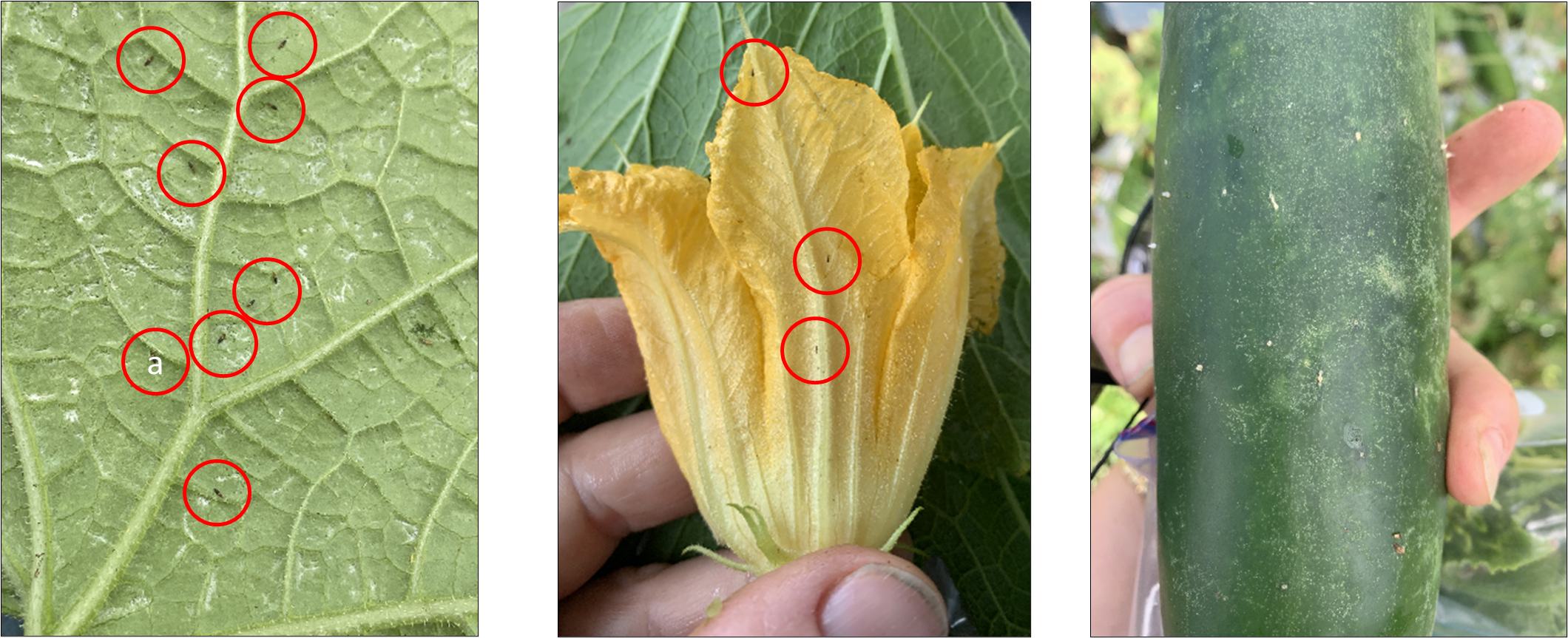 Fig. 8. T. parvispinus females feeding on a cucumber leaf. Photo by Joel Allingham.
Fig. 8. T. parvispinus females feeding on a cucumber leaf. Photo by Joel Allingham.
Fig. 9. T. parvispinus females on a squash flower.
Fig. 10. T. parvispinus feeding injury on cucumber.Communication with stakeholders
Timely communication with stakeholders is crucial upon the first detection of an invasive species. In December 2022, shortly after T. parvispinus was confirmed in a commercial pepper field in Palm Beach County, an information exchange virtual meeting was organized to give an update on the T. parvispinus situation for crop scouts. Scouts were asked to report and send suspected T. parvispinus specimens to extension agents Anna Mészáros and Craig Frey for preliminary identification and before submission to FDACS-DPI for identification confirmation. Participants were encouraged to report detections to the South Florida Pest and Disease Hotline. T. parvispinus updates were presented via multiple platforms such as extension webinars and vegetable seminars at the Florida Citrus Show and Citrus Expo.T. parvispinus distribution
The South Florida Pest and Disease Hotline newsletter has been a crucial tool of our extension program to communicate the spread and population dynamics of pests during the vegetable season (Fig. 11.). As of July 2023, T. parvispinus had been intercepted in nurseries and stock dealers across the state. However, it was confirmed established in the landscape only in five counties (Lake, St. Lucie, Martin, Broward, Palm Beach, Miami-Dade) (Fig 12.). In Palm Beach County, T. parvispinus has been found on pepper, snap bean, cucumber, squash, and zucchini. Among these crops, pepper suffered the most significant damage. Sunn hemp flowers were also sampled, but no T. parvispinus were observed. Fig. 11. Infestation levels of T. parvispinus reported by Pest and Disease Hotline contributors in South Florida, April 2023.
Fig. 11. Infestation levels of T. parvispinus reported by Pest and Disease Hotline contributors in South Florida, April 2023.
Fig. 12. T. parvispinus surveys by FDACS-DPI as of July 2023.Management in vegetable crops
Scouting and early detection are important. This fall, various traps have been set up in vegetable fields in Palm Beach County to monitor T. parvispinus populations in order to help growers with insecticide application timings (Fig. 13-15). So far, T. parvispinus populations seem to be extremely low in Palm Beach County vegetable fields. Fig. 13. Yellow and blue sticky traps are used in vegetable fields for thrips population monitoring.
Fig. 13. Yellow and blue sticky traps are used in vegetable fields for thrips population monitoring.
Fig. 14-15. Yellow and blue sticky traps along with pan traps are used for thrips population monitoring.Common foliar insecticides with thrips activity (see table below) might be considered for T. parvispinus management. However, this is NOT a formal recommendation because we do not have reliable efficacy data for T. parvispinus control on vegetables.
Product
IRAC MoA
Active Ingredient(s)
Lannate
1A
Methomyl
Assail
4A
Acetamiprid
Radiant
5
Spinetoram
Agri-Mek
6
Abamectin
Torac
21A
Tolfenpyrad
Exirel
28
Cyantraniliprole
Minecto Pro
28, 6
Cyantraniliprole, Abamectin
Rimon
15
Novaluron
Cormoran
15,4A
Novaluron, Acetamiprid
Movento
23
Spirotetramat
Managing T. parvispinus will be challenging and will require an integrated approach to complement insecticide applications. The development of production practices reducing thrips populations and the use of natural enemies including predators and pathogens should be studied for integration with insecticide use. Biological control studies are ongoing and additional insecticide screenings in collaborations with stakeholders are being conducted for vegetable production.
For more information on T. parvispinus related to ornamental production please visit UF/ IFAS MREC and TREC websites.
Anna Mészáros1, Julien M. Beuzelin2, De-Fen Mou2, and Craig J. Frey3
1Palm Beach County Extension, University of Florida IFAS, West Palm Beach, FL
2Everglades Research and Education Center, University of Florida IFAS, Belle Glade, FL
3Hendry County Extension, University of Florida IFAS, LaBelle, FL
| 7/7/2023 | Risk Analysis of a Novel Bacterial Disease Management System |
 |
"Bacterial spot on pepper can severely impact yields and increase production costs, thus threatening the long-term viability and profitability of the industry. Novel compounds utilizing biological control agents, systemic acquired resistance inducers, and biostimulants are among the newly developed products for sustainable and effective control of bacterial diseases in peppers. However, though many are proven effective, their adoption is impeded due to the lack of information on the implementation costs. Researchers at UF/IFAS, Southwest Florida Research and Education Center studied the effect 11 different spray programs had on bell pepper yield and disease severity, in 2011. Dr. Wade's group has assessed the economic risks associated with each treatment in 2023 dollars." |
| Dr. Tara Wade Agricultural and Natural Resources Economist |
|
| Website (239)658-3444 tara.wade@ufl.edu |
Keywords: economics, disease, management, risk analysis, peppers, bacterial spot, biostimulants |
-
Read: Risk Analysis of a Novel Bacterial Disease Management System
Florida is the second largest pepper producer in the U.S., but production has decreased in the last 10 years. Bacterial spot on pepper can severely impact yields and increase production costs, thus threatening the long-term viability and profitability of the industry. Novel compounds utilizing biological control agents, systemic acquired resistance induces, and biostimulants are among the newly developed products for sustainable and effective control of bacterial diseases in peppers. However, though many are proven effective, their adoption is impeded due to the lack of information on the implementation costs. Researchers at UF-IFAS, Southwest Florida Research and Education Center studied the effect 11 different spray programs (Table 1) had on bell pepper yield and disease severity, in 2011. This analysis assesses the economic risks associated with each treatment in 2023 dollars.
We conduct partial budgeting and stochastic modeling to assess risks of adopting each treatment. Partial budgeting is used to reflect how each treatment affects the cost of production. The net benefit for each practice is calculated and compared to determine the economic feasibility of each treatment. Production costs come from updating the 2019-20 UF-IFAS budgets to 2023 dollars using inflation factors for fixed and variable costs. Monte Carlo simulations (1,000 draws) were used to randomize prices and yields and deviations in net returns are assessed to determine economic risks. Pepper prices come from USDA-NASS and are the basis for draws from the uniform distribution. Yields come from experiment station trials and the basis for draws from the triangular random distribution.
Results showed that treatments whose average yield is at least 730 bu/acre provided positive net returns; these include spray programs 2, 3, 4, 5, and 7. Boxplots in Figure 1 show the means and deviations in net returns for the five spray programs we find to be viable in terms of average net returns and potential risk. On average, at $4,022/acre, spray program 2 provides the highest net returns and is the riskiest with standard deviation of $4,565/acre. At $2,614/acre, spray program 5 has average net returns that are comparable to program 7 and higher than programs 3 and 4, but with far less deviation in net returns (i.e., standard deviation is $3,043/acre). In essence, risk averse growers may prefer program 5 while risk takers may prefer program 2.
Table 1. Spray program descriptions; weekly applications
Program Num.
Product Description, Quantity/Acre
1
Non-treated water control
2
Manzate Pro Stik 75DG, 2.0 lb; Kocide 3000 DF, 2.0 lb
3
NuCop 50HP, 1.0 lb; Manzate Pro Stik 75DG, 2.0 lb
4
NuCop 50HP, 1.5 lb; Manzate Pro-Stik 75 DG, 2.0 lb
5
NuCop 50HP, 2.0 lb; Manzate Pro-Stik, 2.0 lb
6
Serenade Max WP, 1.0 lb; Kocide 3000 DF, 2.0 lb
7
Serenade Max WP, 1.0 lb; Kocide 3000 DF, 2.0 lb; Manzate Pro-Stik, 2.0 lb
8
Biological a*, 5.0 lb
9
Biological b*, 1.25 lb
10
Kocide 3000 DF, 0.75 lb; Actinovate AG, 3 oz
11
Actigard 50 WG, 0.33 oz; Actinovate AG, 3 oz
*Numbered compounds provided by the cooperator.
Figure 1: Profitability Risk Analysis of Florida Spray Programs with Positive Net Returns
Tara Wade*12, Lonege Ogisma1, Kelvin Amon2, and Pamela Roberts1
1University of Florida-IFAS Southwest Florida Research and Education Center
2Food and Resource Economics Department, University of Florida IFAS, Gainesville, FL
| 5/19/2023 | Best Management Practices: Updating UF/IFAS Fertilizer Recommendations |
 |
"Recently, UF/IFAS created an official “Nutrient Management Program,” led by Dr. Tom Obreza, Professor of Soil, Water, and Ecosystem Sciences. Dr. Obreza recruited faculty teams across the state to amplify IFAS research and extension on priority crops including tomato, potato, and snap bean in south Florida. Legislative funding is being used to conduct phosphorus application and management research on commercial farms. Water management is also a key component of the research. Results will be used to update UF/IFAS recommendations for BMPs. " |
| Dr. Tom Obreza Director of UF/IFAS Nutrient Management Research and Extension Project |
|
| Website (352) 392-1761 obreza@ufl.edu |
Keywords: nutrient management, fertilizer recommendation, phosphorus, water management. |
-
Read: Best Management Practices: Updating UF/IFAS Fertilizer Recommendations
Many UF/IFAS fertilizer and nutrient management recommendations for commercial production of field and forage crops are due for updates as production factors and practices have improved during the last three decades. To that end, the UF/IFAS Nutrient Management Program was recently established, with Dr. Tom Obreza as the Director, to administer the legislative intent of HB 5001, Specific Appropriation 1480A for nutrient management research and SB 1000 for site-specific nutrient management passed during the 2022 legislative session. More information on these bills can be found in the Nutrient Management Research article (4/26/2022) below. Current projects are being carried out on tomato, potato, snap bean, citrus, grain corn, watermelon, hemp, and peaches. Cotton, blueberry, lettuce, and sod production are being considered for addition next year.
After hearing from stakeholders, the UF/IFAS BMP website (now entitled the UF/IFAS Plant Nutrient Research and Education Website, bmp.ifas.ufl.edu) is in reconstruction to create transparency, communicate project implementation details, convey real-time changes to UF/IFAS fertilizer recommendations, and provide a place for stakeholder feedback. The website describes how projects were selected, summarizes all projects initiated in response to 2022 legislative funding, and shows progress reports from each team. The site also contains a set of FAQs that address important BMP-related questions, including the process for updating recommendations, an explanation of the use of provisional recommendations, and the grower benefits of BMP implementation. Finally, the site contains information on the current fertilizer and nutrient management recommendations for studied crops, as well as links to recommendations for other crops, research summaries from which current recommendations are based, as well as multiple FDACS BMP manuals.
UF/IFAS recommendations are also undergoing a format change to more clearly identify with the “4Rs” concept of nutrient management: right rate, right source, right timing, and right placement of fertilizers. But we are also adding the fifth “R”… right water management. Achieving efficient nutrient management goes far beyond the amount of fertilizer applied per acre. It involves the other 3 fertilizer “Rs” plus irrigation and drainage management. We are also looking to the future, beyond the 5Rs, to site-specific nutrient management. Many current projects involve site-specific aspects that will eventually allow growers, extension agents, and consultants to “fine-tune” nutrient management for specific sites based on field and crop characteristics, and perhaps even predicted weather patterns. Thanks to the Florida legislature’s investments, Florida’s nutrient management program is making great strides towards improving crop production and quality while minimizing nutrient losses to the environment.
| 5/03/2023 | Current and emerging diseases threatening sweet corn production |
-100x125.jpg) |
"Dr. Katia Viana Xavier is the Vegetable Pathologist at the UF/IFAS Everglades Research and Education Center. Dr. Xavier and her team are dedicated to working on the identification and management of plant diseases that threaten vegetable crops produced in South Florida." |
| Dr. Katia Xavier Plant Pathologist |
|
| Website (561) 993-1500 kvianaxavier@ufl.edu |
Keywords: plant pathology, sweet corn, tar spot, Phyllachora maydis, northern corn leaf blight. |
-
Read: Current and emerging diseases threatening sweet corn production in South Florida
One of Dr. Xavier's research programs is focused on the development of management strategies for current and emerging diseases, including the ubiquitous northern corn leaf blight (NCLB) and the emergent tar spot disease of maize. Both diseases are challenging corn production in the United States, but science-based management strategies tailored for sweet corn in Florida are lacking.
In 2022, the Foundation for Food & Agriculture Research (FFAR) awarded a Rapid Outcomes from Agricultural Research (ROAR) grant to Dr. Xavier and her collaborator, Dr. Resende (UF/IFAS Gainesville), to address the rapid spread of tar spot in sweet corn. This project aims to select sweet corn hybrids that are resistant to tar spot and identify effective chemical control programs. Additionally, the UF research team is examining the genetic diversity of the fungal pathogen causing this disease (i.e., Phyllachora maydis) and studying the epidemiological factors of tar spot development under South Florida conditions.
Efforts to improve sweet corn production in Florida also include a comprehensive understanding of the NCLB pathosystem and the development of a breeding program for NCLB resistance. Dr. Xavier and Dr. Resende's ongoing research can also impact sweet corn growers and markets throughout the United States. Such efforts will bolster the progression of management protocols for current and emerging sweet corn diseases. Additional information from the UF/IFAS Sweet Corn Breeding Lab can be found here: UF | Resende Lab - Sweet Corn Breeding.
Acknowledgments:
The sweet corn tar spot project is supported by a FFAR-ROAR grant ID 22-000443.
| 3/24/2023 | Monitoring Insect Vectors and Emerging Diseases in South Florida |
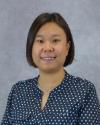 |
"Dr. De-Fen Mou is a new entomologist at the UF/IFAS Everglades Research and Education Center. Dr. Mou and her team seek to help Everglades Agricultural Area growers to solve issues related to insect vectors that transmit plant pathogens." |
| Dr. De-Fen Mou Entomologist |
|
| Website (561) 993-1529 defenmou@ufl.edu |
Keywords: insect vectors, plant virus, lettuce, thrips, Impatience necrotic spot virus |
-
Read: Monitoring Insect Vectors and Emerging Diseases in South Florida
Did you know that plants also get sick? Plant virus infection can induce disease symptoms that reduce crop value such as necrosis, discoloration, lesions, and affect crops’ normal growth and development. More importantly, virus infection can cause plant death and hence cause huge economic loss to crop growers. Many plant viruses are transmitted by insects. These “insect vectors” use their needle-like mouthpart structure, called “stylet”, for piercing plant tissue and sucking plant sap, and the virus transmission happens when they feed on plants.
The research of Dr. Mou of the UF/IFAS Everglades Research and Education Center (EREC) focuses on identifying which insect species is responsible for plant pathogen transmission and studying the transmission mechanisms. Based on this research, her goal is to develop management tools to target the vector species and control virus diseases. The first phase of her program is to initiate a monitoring program for insect vectors and emerging diseases of important crops at the Everglades Agricultural Area.
Recently, a thrips-transmitted virus disease of lettuce caused by Impatiens necrotic spot viruses (INSV) severely impacted lettuce production in California. Dr. Mou is plan to monitor thrips population levels in Florida lettuce farms and screen the thrips for INSV to make sure Florida lettuce is not affected by the virus. Additionally, in collaboration with Dr. Germán Sandoya who leads the lettuce breeding program at the UF/IFAS EREC, Dr. Mou will examine lettuce resistance to the thrips. Ultimately, Dr. Mou will merge insect ecology, molecular biology, and vector entomology to develop measures that prevent the outbreak of the INSV in Florida lettuce.
| 3/04/2023 | Crunching the Numbers using AgTools technology |
 |
"Dr. Kimberly Morgan’s research program goals are centered on measurable real-world needs communicated by Florida’s rural, natural resource, and agribusiness owners, managers and consumers. This includes pursuing research that serves to inform decisions made by producers. AgTools is an exciting new technology that Dr. Morgan works with which enables growers to make more informed daily production and harvest decisions by offering access to over 29 years of crop-specific records, such as market demands, labor trends, transportation costs, and more." |
| Dr. Kimberly Morgan Agricultural Economist |
|
| Website (239) 658-3400 kimorgan@ufl.edu |
Keywords: agricultural economics, market analysis, economic risk, market demands, decision making, AgTools |
-
Read: Crunching the Numbers for Tomato using AgTools technology
Economic risk is the possibility of adversity or loss and refers to “uncertainty that matters.” In agriculture, risks include production, financial, human resource, marketing, and legal and/or regulatory risk. Risk management involves choosing among available alternatives to reduce the effects of risk. Managing uncertainty requires evaluation of tradeoffs between choices, changes across and within areas of risk, knowledge of expected returns, degree of desired entrepreneurial freedom, and other measurable factors. Optimal decision-making occurs where the marginal gains meet or exceed marginal costs of each choice and drives an individual producer’s ability to compete in the markets.
Given that market access and market share drive profitability, exciting new technologies are emerging that reduce the cost of KNOWING and empower the individuals making more informed decisions. Built by a family of farmers, AgTools developed algorithms to calculate a billion transactions per second, helping farmers and commodity buyers understand how scores of factors can affect their contracts for the produce supply chain. A subscription-based service specific to each fruit or vegetable and informed by experienced producers and retail buyers, the AgTools engineers find and organize current and historical secondary data. Commodity data with over 76 variables and 29 years of records such as market demands, labor trends, transportation costs, and more, are capturing data used by growers to make daily production and harvest decisions at the margin. Some of these variables include market price data, import data and trends, fuel and labor costs over time, current and optimal weather, measures of sustainability (food miles), up to the minute news specific to commodity, and a brand-new feature allowing buyers to see real-time growth stages of each crop and any reported disease issues unique to the production region.
Below are demonstrations of why this technology offers time-saving ways to improve marketing decisions using the AgTools up-to-the-minute shipping point price and volume trends for the 2022-23 tomato season (1 Oct 2022 through 3 February 2023):


Please contact Dr. Morgan to request additional information about AgTools and/or request a market analysis. She maintains AgTools subscriptions for tomato, tomato (plum-type), blueberries, oranges, peppers (bell-type), peppers (other), romaine lettuce, spinach, strawberries, watermelons, watermelons (seeded), and watermelons (seedless).
| 2/09/2023 | Bacterial Diseases on Pepper |
 |
"Dr. Pamela Roberts and her team are investigating bacterial diseases that occur on pepper ‘to reduce economic losses in pepper production caused by foliar bacterial pathogens and develop strategies to minimize losses from bacterial diseases on pepper’. The team members are identifying and characterizing the bacteria occurring on all types of pepper, developing detection assays, breeding for resistance, evaluating new materials for management, and evaluating the economics associated with management practices." |
| Dr. Pamela Roberts Plant Pathologist |
|
| Website (239) 658-3430 pdr@ufl.edu |
Keywords: pepper, Xanthomonas, Xanthomonas euvesicatoria, resistance breeding, new management strategies |
-
Read: Bacterial Diseases on Pepper
In 2019, a USDA-SCRI grant was funded to investigate bacterial diseases that occur on pepper. The grant members are comprised of research and extension faculty at UF, five other universities, and USDA, from the disciplines of plant pathology, plant breeding, and economics. The overarching goal of this project is ‘to reduce economic losses in pepper production caused by foliar bacterial pathogens and develop strategies to minimize losses from bacterial diseases on pepper’. The team members are identifying and characterizing the bacteria occurring on all types of pepper and developing detection assays, breeding for resistance, evaluating new materials for management, and evaluating the economics associated with management practices.
Studies from this project include characterizing the current population of the bacterial spot pathogen caused by Xanthomonas species from field surveys initiated in southwest Florida. More than 500 strains of bacteria were isolated from peppers, including leaves and fruit, with symptoms typical of bacterial spot. Samples were collected from a wide variety of peppers including bell, mini sweets, Cubanelle, jalapenos, and other specialty-type peppers beginning in 2019. Strains were then characterized for pathogenicity, race, sensitivity to copper, and sensitivity to an antibiotic. From this sampling, most of the bacteria were Xanthomonas euvesicatoria and were mainly races 1, 3, and 6 with four other races detected infrequently. Approximately two-thirds of samples were copper tolerant and only a few of them showed antibiotic resistance.
This most recent population study of pepper bacterial diseases in south Florida offers insights into management. Using resistant varieties to the main races detected should be the first management strategy employed. Additionally, results indicate potential effectiveness of copper and antibiotic management for bacterial spot. For further assistance in developing a bacterial spot management plan, contact your local extension agent and/or the UF Plant Pathology team.
Acknowledgements:
Aastha Subedi, Graduate Research Assistant, Plant Pathology Department. Jeff Jones, Distinguished Professor, Plant Pathology Department. Erica Goss, Associate Professor, Plant Pathology Department and Emerging Pathogens Institute. University of Florida.
This work is supported by the United States Department of Agriculture Specialty Crops Research Initiative project [grant no. 2019-51181-30010/project accession no. 1020301] from the USDA National Institute of Food and Agriculture.
| 1/17/2023 | Studying fumigation impacts on soil microbes to improve production |
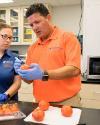 |
"UF soil microbiologist Dr. Sarah Strauss is investigating how the use of fumiagants impacts non-target microbes in the soil for Florida tomato and strawberry crops. Joining her investigation are weed scientist Dr. Nathan Boyd, plant pathologist Dr. Gary Vallad, and soil scientist Dr. Mary Lusk." |
| Dr. Sarah Strauss Soil Microbiologist |
|
| Website (239) 658-3468 strauss@ufl.edu |
Keywords: soil microbes, fumigants, tomato, strawberry |
-
Read: Studying fumigation impacts on soil microbes to improve production
Fumigation has been a standard practice for vegetable production for over 50 years and can be an effective method to control some soilborne plant pathogens. However, the efficacy of fumigants can vary and it’s not clear how fumigants impact the other microbes in the soil (i.e. the non-target microbes). Many soil microbes (bacteria and fungi) can be beneficial for plant growth, so understanding if these beneficial microbes are still in the soil after fumigation, and how long it takes for them to return to the soil, could help optimize or improve fumigation practices.
Dr. Sarah Strauss was awarded a grant from USDA-NIFA to address these questions for fumigants commonly used in Florida tomato and strawberry production. In addition, the project will examine how changes in non-target soil microbes might impact the suppression of soilborne plant pathogens, nutrient availability, and weed growth. Weed scientist Dr. Nathan Boyd, plant pathologist Dr. Gary Vallad, and soil scientist Dr. Mary Lusk are joining her on the project to help address these questions.
The first phase of the project is focused on tomato field trials being conducted at the UF/IFAS Gulf Coast Research and Education Center (GCREC), where soil microbes and pathogen abundances are being assessed at frequent intervals after fumigation and throughout the production cycle. Fumigants being assessed include Telone C35, Pic-Clor 60, Pic100, K-pam, Pic-Clor 60 + K-pam, and a no treatment control. The next phase of the project will involve working with Florida strawberry and tomato growers to collect samples in commercial fields.
Interested in learning more about fumigant impacts on soil microbes or participating in our trials? Contact Dr. Strauss and Craig Frey for more information.

